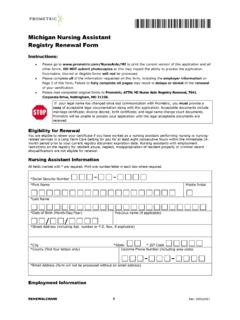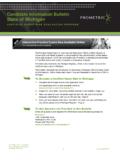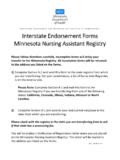Transcription of STATE OF MICHIGAN
1 1 STATE OF MICHIGAN nurse AIDE TRAINING CURRICULUM MODEL MICHIGAN Department of Licensing and Regulatory Affairs Bureau of Health Care Services (Revised, 2014) OBRA-6 (2004) Authority: PL 100-203 2 Section A .. 4 Introduction .. 4 Adult Learning .. 4 Introduction to Culture Change .. 122 First Revision Curriculum Model, 1991 .. 144 Second Revision Curriculum Model, 2006 .. 144 Federal Requirements .. 166 Program Objectives .. 166 Curriculum and Training Requirements .. 166 Requirements for Instructors in nurse Aide Training Programs .. 177 Equipment and Supplies for nurse Aide Training Program .. 19 Section B .. 244 Curriculum Matrix nurse Aide Training MICHIGAN Model Curriculum, 2006 .. 244 Recommended Hour Allocation MICHIGAN Model Curriculum, 2006 .. 266 Sample 75 Hour Program Schedule.
2 277 Section C: .. 29 Lesson Plan .. 30 Section D:.. 91 Resources For Selected Units .. 91 Section E: .. 93 References .. 93 Section F: .. 96 Glossary .. 96 Section G:.. 100 Students Achievement Record (SAR) .. 100 TASK 6-1: Handwashing .. TASK 6-2: Standard Precautions .. TASK 7-1: Assisting the resident who falls .. TASK 7-2: Assisting the resident having a seizure .. TASK 7-3: Assisting an unconscious TASK 7-4: Assisting the resident who is TASK 7-5: Assisting the resident who is bleeding .. TASK 7-6: Heimlich maneuver .. TASK 7-7: Fire preparedness .. TASK 8-1: Denture care .. TASK 8-2: Oral hygiene (minimal and total assistance) .. TASK 8-3: Oral hygiene/ unconscious resident with teeth or without teeth or dentures .. TASK 8-4: Fingernails/cleaning and trimming.
3 TASK 8-5: Foot care .. TASK 8-6: Shampoo in bed .. TASK 8-7: Hair Care- styling (comb and brush).. TASK 8-8: Shaving- blade or electric razor .. TASK 8-9: Perineal care male .. TASK 8-10: Perineal care female .. TASK 8-11: Bathing/ tub shower .. TASK 8-12: Bathing bed-bath .. TASK 8-13: Skin care/inspection .. 3 TASK 8-14: Dressing .. TASK 9-1: Bed Operation .. TASK 9-2: Making an unoccupied bed .. TASK 9-3: Making an occupied bed .. TASK 11-1: Application of restraint alternatives and a waist restraint .. TASK 12-1: Measure and record temperature oral axillary rectal aural (tympanic or ear) .. TASK 12-2: Take/record pulse .. TASK 12-3: Take/Record TASK 12-4:Take/Record Blood Pressure (one-step method) .. TASK 12-5: Take/record height and weight.
4 TASK 13-1: Providing hydration and nutrition for resident in bed and record intake .. TASK 13-2: Measure/Record Intake and Output .. TASK 14-1: Assist with bedpan and urinal .. TASK 14-2: Assist with bedside commode .. TASK 14-3: Catheter care .. TASK 14-4: Urine/Stool Specimen TASK 15-1: Proper Body Mechanics .. TASK 15-2: Ambulate Resident .. TASK 15-3: Transfer Resident from Bed to Wheelchair .. TASK 15-4: Position Resident on Side in Bed .. TASK 15-5: Turn Resident in Bed .. TASK 15-6: Mechanical Lift .. TASK 15-7: Range of motion upper and lower extremity .. TASK 15-8: Walker Assistance .. TASK 15-9: Cane Assistance .. TASK 15-10: Wheelchair assistance .. TASK 18-1: Postmortem care .. 4 Section A Introduction Background In 1987, Congress included, in the Omnibus Budget Reconciliation Act (OBRA), legislation affecting the operation of nursing homes.
5 A section of the legislation stated that all nurse aides employed in nursing facilities after October 1, 1990, must successfully complete a minimum 75 hours of training which includes classroom, laboratory, and clinical instruction in a STATE approved nurse aide training program. nurse aides in nursing homes must also pass a competency evaluation test (written and clinical) and have their names entered on a STATE registry. The STATE Department of Licensing and Regulatory Affairs is the agency in MICHIGAN , which is charged with implementation of this legislation. As part of this implementation, the MICHIGAN nurse Aide Training Curriculum, 1989, was developed to be used by instructors in the nurse Aide Training Program in a variety of ways: as a curriculum guide to be used in the development of a 75 hour training program, as a complete curriculum to be used as is, or adapted to fit specific facilities or training programs.
6 Adult Learning The approach to adult learning is based on the belief that adults learn differently from children, and thus should be taught differently. The American educator Malcolm Knowles coined the term andragogy to refer to the art or science of helping adults to learn. The following principles of adult learning are based on Knowles s work: Principles of Adult Learning Adult learning occurs best when it: Is self-directed Fills an immediate need Is participatory Is experiential Is reflective Provides feedback Shows respect for the learner Provides a safe atmosphere Occurs in a comfortable environment Many of these principles are applied and demonstrated in the Adult Learning Cycle. The cycle begins with an experience that the adult can either learn from, or not.
7 The next steps in learning are to reflect on the experience, then generalize about what happened, and then apply the new learning to other situations, to see if it holds true outside the learning environment. 5 The trainer can facilitate the adult learning cycle by designing appropriate activities for each step and asking questions to guide the adult learner. The following table outlines the tasks and role of the trainer: Adult Learning Cycle Phase Activities Trainer s Role Questions to ask 1. Direct Experience Group tasks Case studies Role plays Skills practice Games Structure the experience present objectives, instructions, and time frame What is the purpose of this activity? What else do you need to know to carry out this activity? How is it going? How much more time do you need?
8 2. Reflecting on the Experience Small-group discussion Reporting from small groups Participant presentations Large-group discussion Ask questions to help the learner to focus on key points and to share ideas and reactions with others What happened? How did you feel What did you notice How do others feel Why do you agree or disagree? 3. Generalizing about the Experience Large-group discussion Lectures Demonstration Reading Ask questions and provide key information to guide the learner to new insights based on experience and discussion What did you learn from this? How does all that we re discussing fit together? What are some major themes we ve seen here? 1. Direct Experience 2. Reflecting on the Experience 3. Generalizing about the Experience 4. Application 6 4. Application Discussion Action planning Skills practice Field visits Coach the learner by providing feedback, advice, and encouragement How can you apply this in your own situation?
9 What do you think will be most difficult when you use this? If you were to use this in your own situation, how would you do it differently? How can you overcome barriers to applying what you have learned? Matching Training Methodologies to Learning Objectives The activities listed in the Adult Learning Cycle table vary according to the phase of the learning cycle. This reflects the fact that different types of activities work better for different phases of learning. Another way of thinking about this is to consider the objectives of the learning event (or training). Objectives for job-related trainings are commonly grouped into three categories knowledge, attitudes, and skills. This is based on the recognition that, in order to apply new learning on the job, trainees must not only know the information or tasks that they are to apply or carry out, but also must have the practical skills necessary to do so, plus the attitude that this is something they can and should do.
10 In general, trainers group the following methodologies with each type of learning objective: Knowledge: Lectures; findings; audiovisuals Skills: Demonstration, followed by practice with feedback; case studies (problem-solving); role plays; games Attitudes: Role plays; small-group discussion; case studies; games In the 1970 s, surveys of trainers to rank training methods for effectiveness indicated that experiential activities such as case studies, role playing, games, and discussion were considered more effective than formal lectures and films -- even for the knowledge-based objectives. However, lecturing is still considered one of the most cost-effective approaches to delivering new information in a short period of time. Thus, most trainers have developed an interactive approach to lecturing, which is described in more detail below.














